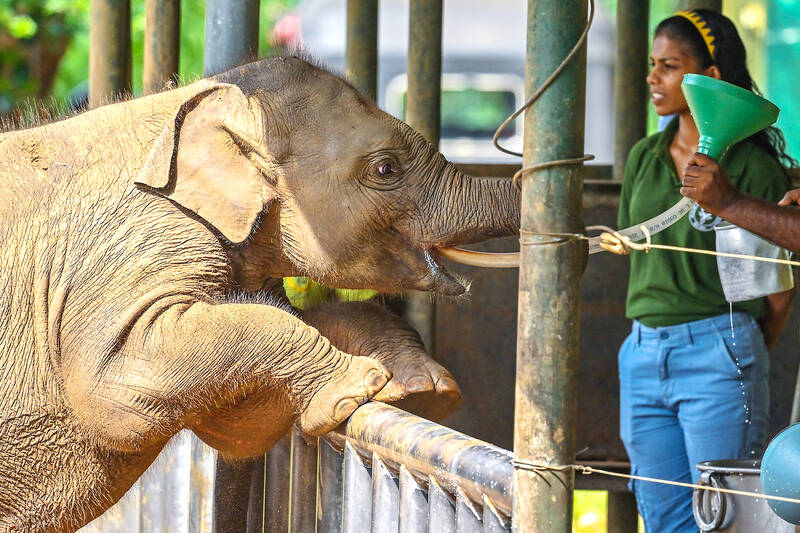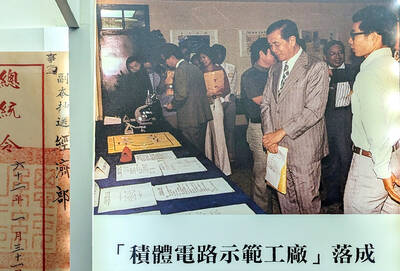A pile of something resembling chocolate raisins is displayed on what looks like a cake base. There’s an artful assemblage of something the size and shape of oysters — and isn’t that chocolate torte and sticky toffee pudding over there?
“They look like something from Bake Off,” says Tracey Lee, an artist and former zookeeper, whose unique collection of animal excrement goes on public display for the first time this weekend in London.
From the distinctive square nuggets of the wombat to the minuscule hand grenades of the death’s head hawkmoth caterpillar, the produce of 120 different rear ends make up The Origin of the Feces: Poo at the Zoo.

Photo: AFP
The exhibition, which opens at Fusebox in Kingston upon Thames, is the result of more than 20 years of collecting, which began for Lee when she had to say goodbye to her favorite elephant, Geetha. One evening in 2001, she loaded the elephants on to trucks to move them from London Zoo to ZSL’s sister zoo, Whipsnade, so they could enjoy more space.
“When you work with these animals you fall in love with them. They become your family,” she says. “You’re with them from 7:30 in the morning until 6:30 at night. If they’re sick, you stay overnight with them. You’re there on Christmas Day. As the truck left and drove out into the dark, I remember feeling really bereft. It was awful. I picked up one of Geetha’s poos, held it and thought, ‘This is the last thing I have of Geetha.’”
Lee was awakened to the artistic potential of number twos in the 1990s when, as elephant keeper, she collected elephant dung for the artist Chris Ofili, drying it in the zoo’s boiler room.

Photo: AFP
When London Zoo’s rhinos, Rosie and Jos, were also moved to more spacious zoos, Lee took another memento.
“I know you shouldn’t have favorites but I just loved Jos to bits. I picked up his poo and put it next to Geetha’s in the boiler room. I know it sounds weird. And that’s how it began.”
Over the next two decades, Lee assembled her collection, drying out the stools and storing them in a friend’s barn and in her allotment shed. She would visit friends working at other zoos and leave with a car boot-load of crap.

Photo: AFP
For authentic splatter, she drops them on to a mount from the same height as the animal’s bum, and preserves them in PVA glue.
Although now odorless and hygienic, the exhibits are a feast for the senses.
Okapi (forest giraffe) manure looks like glossy chocolate raisins. Zebra dung is the same shape and size as oysters. The sizeable discharge of the Galapagos tortoise “looks like a giant tadpole or sperm with the tail on them,” thinks Lee, who two years ago moved from keeper duties to become ZSL’s “creative operative” — painting zoo spaces, leaflets and signs.
Elephant excrement is unexpectedly modest but they produce 10 or more of each chunk at a time. The strangest fecal matter belongs to Zaire, one of London Zoo’s most cherished gorillas, who died three years ago. It looks like a giant kebab.
“She was an absolutely wonderful animal, funny and intelligent and just beautiful,” Lee says. “She was very greedy and used to barge everyone out of the way to get the best bits of food — she did giant poos because she ate so much.”
The exhibition includes donations from endangered birds — collected on canvasses placed below their favorite perches — reptiles and invertebrates.
The stinkiest — before being dried and made hygienic — belonged to the African wild dog. The smallest offering was probably the grape seed-sized poos of the Partula snail, extinct in the wild but being reintroduced via captive-breeding programs.
The exhibition, which runs until Oct. 28, already has more than 1,000 schoolchildren booked to see it.
Robin Hutchinson, founder of the exhibition organizers The Community Brain and the charity Creative Youth, says: “This is a brilliant exhibition because it gives visitors permission to talk about poo — and that’s something that appeals to people of all ages. I’m especially keen to use Tracey’s amazing exhibition to connect young people to the real plight of the natural world.”
But one mammal is not represented in the collection. “The only one I haven’t done is human,” says Lee. “Please don’t ask — no way!”

Oct. 27 to Nov. 2 Over a breakfast of soymilk and fried dough costing less than NT$400, seven officials and engineers agreed on a NT$400 million plan — unaware that it would mark the beginning of Taiwan’s semiconductor empire. It was a cold February morning in 1974. Gathered at the unassuming shop were Economics minister Sun Yun-hsuan (孫運璿), director-general of Transportation and Communications Kao Yu-shu (高玉樹), Industrial Technology Research Institute (ITRI) president Wang Chao-chen (王兆振), Telecommunications Laboratories director Kang Pao-huang (康寶煌), Executive Yuan secretary-general Fei Hua (費驊), director-general of Telecommunications Fang Hsien-chi (方賢齊) and Radio Corporation of America (RCA) Laboratories director Pan

President William Lai (賴清德) has championed Taiwan as an “AI Island” — an artificial intelligence (AI) hub powering the global tech economy. But without major shifts in talent, funding and strategic direction, this vision risks becoming a static fortress: indispensable, yet immobile and vulnerable. It’s time to reframe Taiwan’s ambition. Time to move from a resource-rich AI island to an AI Armada. Why change metaphors? Because choosing the right metaphor shapes both understanding and strategy. The “AI Island” frames our national ambition as a static fortress that, while valuable, is still vulnerable and reactive. Shifting our metaphor to an “AI Armada”

The older you get, and the more obsessed with your health, the more it feels as if life comes down to numbers: how many more years you can expect; your lean body mass; your percentage of visceral fat; how dense your bones are; how many kilos you can squat; how long you can deadhang; how often you still do it; your levels of LDL and HDL cholesterol; your resting heart rate; your overnight blood oxygen level; how quickly you can run; how many steps you do in a day; how many hours you sleep; how fast you are shrinking; how

“‘Medicine and civilization’ were two of the main themes that the Japanese colonial government repeatedly used to persuade Taiwanese to accept colonization,” wrote academic Liu Shi-yung (劉士永) in a chapter on public health under the Japanese. The new government led by Goto Shimpei viewed Taiwan and the Taiwanese as unsanitary, sources of infection and disease, in need of a civilized hand. Taiwan’s location in the tropics was emphasized, making it an exotic site distant from Japan, requiring the introduction of modern ideas of governance and disease control. The Japanese made great progress in battling disease. Malaria was reduced. Dengue was